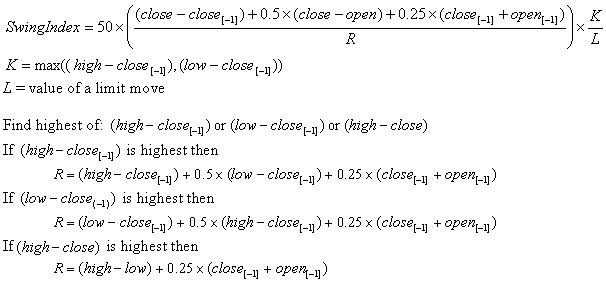
To use this application , the following formula is used : ‘ SI(i) = 50*(CLOSE(i-1) – CLOSE(i) + 0,5*(CLOSE(i-1) – OPEN(i-1)) + 0,25*(CLOSE(i) – OPEN(i)) / R)*(K / T) ASI(i) = SI(i-1) + SI(i) Where: SI (i) — current value of Swing Index technical indicator; SI (i – 1) — stands for the value of Swing Index on the previous bar; CLOSE (i) — current close price; CLOSE (i – 1) — previous close price; OPEN (i) — current open price; OPEN (i – 1) — previous open price; R — the parameter we get from a complicated formula based on the ratio between current close price and previous maximum and minimum; K — the greatest of two values: (HIGH (i – 1) – CLOSE (i)) and (LOW (i – 1) – CLOSE (i)); T — the maximum price changing during trade session; ASI (i) — the current value of Accumulation Swing Index.
The formulae leads to a daily value that lies between -100 and +100. Signals These rules apply only to the ASI and must be correlated with the price action point. Buy Signal: Upside Breakout â?? ASI exceeds a previously significant High Swing Point Sell Signal: Downside Breakout â?? ASI drops below a previously significant Low Swing Point | 






Nessun commento:
Posta un commento